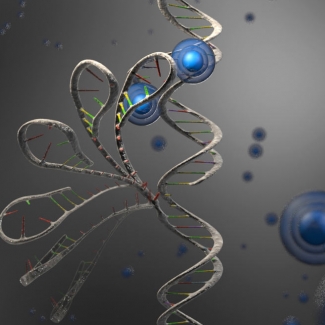The Nesbitt group has been investigating RNA folding since the early 2000s. The group’s goal has been to gain a detailed understanding of the relationship between structure and function in this important biomolecule. One challenge has been figuring out how unfolded RNA molecules assume the proper three-dimensional (3D) shape to perform their biological activities. To accomplish this, the researchers have shown how biologically active RNA is able to neutralize negative charges that end up in close proximity to each other after folding into a 3D structure.
To understand how RNA folds, the Nesbitt group makes small pieces of RNA that contain one site critical to 3D folding and study how this site (called a tetraloop) lightly binds, or docks, to a receptor region. The docking and undocking process is somewhat like fastening and peeling apart molecular Velcro.
The Nesbitt group immobilizes a single piece of RNA on a slide. The RNA contains both a single tetraloop and its receptor. The group uses a laser to observe how the RNA structure changes in response to changing concentrations of ions such as magnesium (Mg2+) or sodium (Na+). For several years, the group has known that RNA stays folded longer with increasing amounts of Mg2+. The conventional explanation for this observation was that the Mg2+ ions were neutralizing the negative charges on the RNA tetraloop, making it easier for the tetraloop to dock into the receptor and stay that way.
Former graduate student Julie Fiore, graduate student Erik Holmstrom, and Fellow David Nesbitt recently looked at the folding process in greater detail. They confirmed that as the concentration of Mg2+ ions increases, the RNA tetraloop stays folded longer. But, when they raised the temperature (which tends to unfold RNA), they found that the tetraloop didn’t unfold as much if more Mg2+ was present. This result suggested that there was more to the story of Mg2+ ion and RNA folding than just neutralizing the negative charges in the RNA molecule.
According to Holmstrom, the rest of the story goes like this: When there’s more Mg2+ around, it gets easier for the RNA tetraloop to pull Mg2+ ions close to it. That’s why it folds better — it’s simply much easier to get the exact number needed for it to fold and be able to link to its docking site.
It turns out that the RNA tetraloop must capture about two Mg2+ ions to be able to dock the tetraloop into the receptor. When there’s a lot of Mg2+ around, the capture process gets easier. It gets easier because taking a few Mg2+ away from a solution with lots of ions doesn’t change the amount of disorder, or entropy, in the system very much. That’s because there are still too many Mg2+ ions left in the solution for them to be able to move farther apart.
In the future, the Nesbitt group plans to investigate whether the effects on the tetraloop of increasing the concentration of Na+ are the same as with Mg2+. Preliminary results suggest there may be some differences: Higher concentrations of Na+ may also make it easier to pull Na+ into the tetraloop. However, the Na+ may actually change the structure of the tetraloop — something doesn’t appear to happen with higher concentrations of Mg2+ ions.




